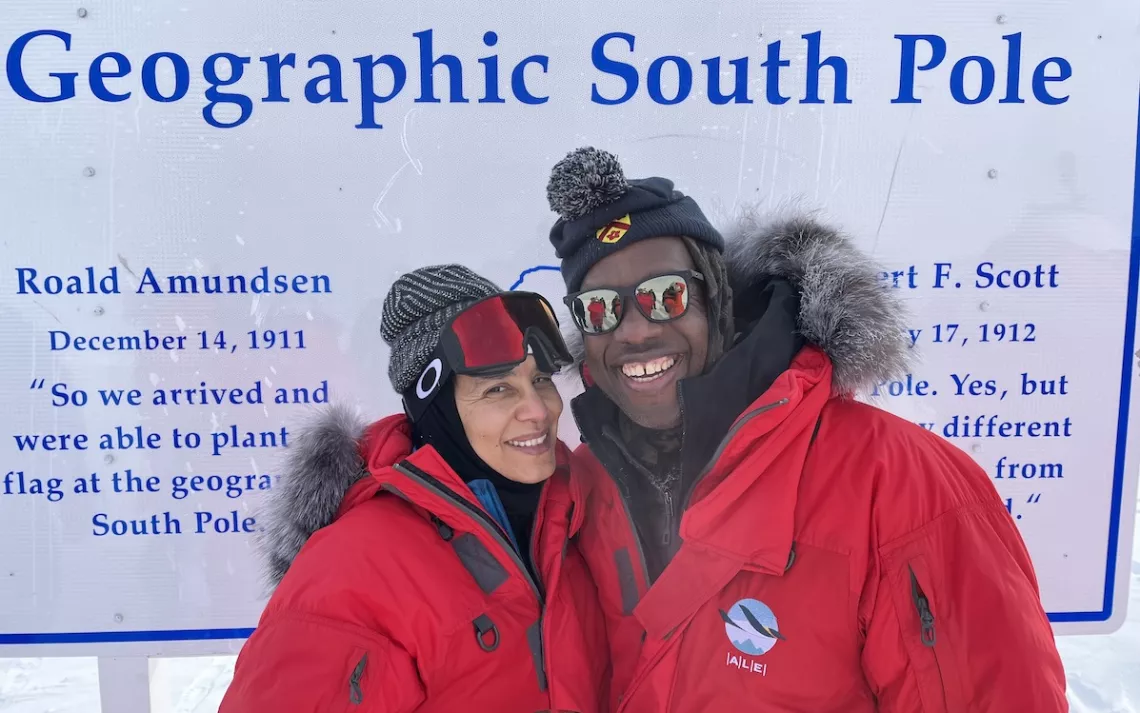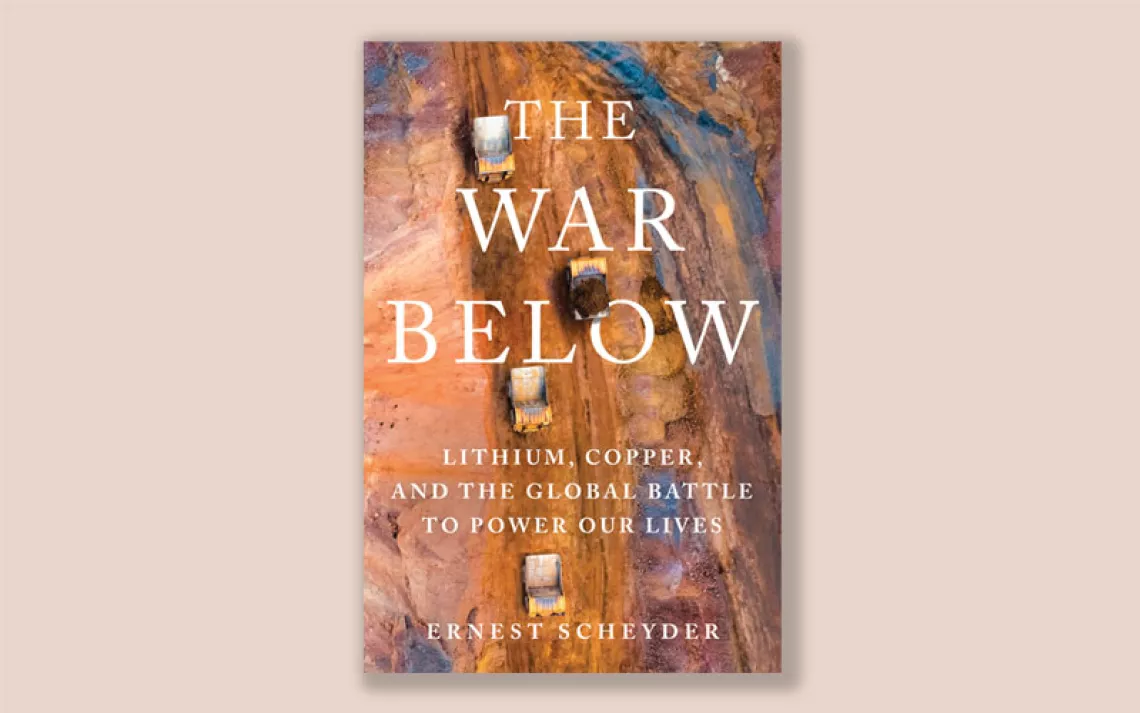African Joy on the White Continent
An excerpt from the new book "Between Starshine and Clay"

Photos courtesy of Sarah Ladipo Manyika
“Thirty. Twenty. Ten.” I can hear the countdown from the cockpit and then comes the bump as we hit the blue ice runway, the White Continent speeding forward, rattling, and lurching to the left, to the right. I hold my breath and hold it, hold it … until I feel the plane begin to slow. Then, with relief, I join in a burst of applause. We have landed in Antarctica. When it’s my turn to disembark, I do so tentatively, weighed down by a heavy polar coat and boots.
The little of me that isn’t at least triple-wrapped—namely my nose—feels the sharp prick of cold as I squint in the blinding light, taking in a blue ice rink that stretches as far as my eyes can see. We have landed on a long strip of glacial ice blown free of snow. Next to it are two storage containers, several large drums of jet fuel roped together, and two snow vehicles that add a bright pop of orange and blue to the pale-blue ice and white snow. Even with sunglasses, everything here is bright, too bright—the sun, the ice, the snow.
I glance back down at my massive black boots and the slick ice and brace myself. The air is filled with ice crystals within which my breath turns to white puffs. With each step, my clothes make shuffling noises. Half astronaut, half Matryoshka nesting doll, my outer layer is a long, bright-red polar jacket worn over heavily insulated black trousers. Beneath these, I wear three more layers. We have stepped outside for just a few minutes, so the additional recommended layers—another fleece top, a windproof jacket plus neck gaiter, balaclava, and extra-heavyweight woolen socks—remain in my duffle bag for when we get to camp farther inland. But now, despite my layers, my legs have started to shiver and won’t stop. It feels like malaria, but this is no illness. Just cold, damn cold! So cold that here, some 80 miles into Antarctica’s interior, there are no birds, insects, or vegetation. With the exception of the three humans here to meet us, there is no life.
The snowcat, which will take us 22 miles farther inland, looks like a small school bus with four giant triangular tracks for wheels. I climb in through the back stairs, glancing at our luggage, which is stacked up amidst fine trails of snow and ice. There are 15 of us including my husband, expedition guides, and a glaciologist. Outside, the snow-covered peaks look like meringues and on the white-white snow our vehicle’s shadow is the same royal blue as the sky.
As we set off, our expedition guide explains how the route has been mapped out ahead of time with ground-penetrating sonar to detect any cracks in the ice. These crevasses, which run as deep as 60 meters and as wide as nine meters, are invisible to the naked eye when lightly filled with snow drift. As such, whenever we stop, we’re advised not to wander beyond the demarcated route. Our glaciologist, who has lost colleagues to crevasses, once had a narrow escape himself. If you hit one, he advises wryly, hope to fall deep and hard as there’s little chance of being rescued.
We journey for another two hours, passing the Ellsworth mountain range, whose peaks are completely submerged beneath glacial ice and snow. Occasionally, bare granite peaks, called nunataks, protrude from the ice like a monument from another era. The absence of life makes it feel both extraterrestrial and prehistoric. It’s hard to even imagine what this place would be like without the thick blanket of ice, yet 90 million years ago, dinosaurs roamed the continent in temperate rainforests. I begin to think in geological time.
Growing up, I didn’t know that Antarctica was the world’s largest polar desert and the size of India and China combined, but I did know something about deserts. I lived in the northern city of Jos, Nigeria, 1,500 miles from the Sahara Desert, and during harmattan season the winds brought in the fine cinnamon Saharan dust. I was mesmerized by tales of the Sahara—its vastness, the extreme heat, the beauty and terror of it, but most of all by stories of its nomadic peoples. Antarctica’s polar desert feels analogous in terms of its striking beauty and lurking terrors, but it’s bigger, much bigger, cold and empty.
AFRICAN AT THE POLE
Fela Kuti! I’ve encountered his Afrobeat all around the world but wasn’t expecting to hear it here. The staff at the Three Glaciers camp are in the kitchen chopping and dancing and it’s Gordo from Argentina who smiles and says, “We’re missing the African continent, so we have Fela Kuti to represent, represent!” And, just like that, Antarctica becomes the warmest coldest place on Earth.
It’s Gordo who takes my phone and snaps pictures of us when, at the ceremonial South Pole, I clutch my green and white Nigerian flag alongside my husband who proudly holds his stripy green, yellow, and red Zimbabwean flag. When we had learned we would be among the first from our respective countries of origin to set foot on the South Pole, we’d hastily purchased flags online, which we attempt to unfurl in the foul wind and wave in our triple layers of gloves and mittens.
Afterward, scrunching my way across the ice and breathing heavily from the thin air, I walk to the shipping container that serves as the passport stamping area for the Amundsen-Scott South Pole Station. There, one of my traveling companions stamps my passport with the official stamp—not once, but twice, just to make sure the ink is clear. South Pole Station. United States Antarctica Program, January 14, 2022. I marvel at how carefree and lackadaisical the stamping has been. For the first time in my life, there are no immigration officials scrutinizing my passport or looking me up and down deciding whether to give me a hard time or not. It feels too good to be true. Maybe it is too good to be true. What will happen next time I pass through American immigration? Will they look suspiciously at these stamps? Will they ask me why there are two stamps rather than one? Will they ask me who stamped my passport? Will they ask me to step aside for further questioning? What if they seize my passport? Does anyone else feel the way I’m feeling now? I look to my husband, the other African.
And yet and yet and yet, being in Antarctica makes me feel the least Black or African I have felt in a very long time and this surprises me. I’m thrown against a sharp white background here, but I feel the least colored, the most human. References to Black and white—be it to people or lands—are usually such loaded terms due to the ugliness of history, but here they seem to lose their baggage.
This “white continent” is merely a topographical descriptor for land that belongs to all. I learn that under the Antarctica Treaty of 1959, the continent is maintained by a coalition of nations. According to the treaty, no one can claim ownership of any of it, and no military exercises or mining of any sort can be conducted on the continent—only scientific research is allowed. The governing of this continent is extraordinary and has worked for more than 60 years. Here, on land that belongs to no one in particular, but to all, humans work together to be good stewards of the larger land, Earth.
Back in San Francisco, I walk with my one-hundred-and-three-year-old friend Willard. She tells me how she researched Antarctica and the South Pole while I was gone. “Cold, cold, cold. Cold, huh?!” she asks as we chuckle together. Instinctively, I reach for my phone, the way Preet did, to show just how cold—but then tuck it away. There’ll be time enough for photos at the end when we sit on her stoop to catch our breath. And as we walk and talk, I keep returning to Hannah’s question. What will I do with this gift of having been to the South Pole? It’s a question I haven’t been able to shake since I’ve been back. Several blocks later, as though reading my thoughts, Willard stops and turns to me.
“Remember when we stood here and you asked, do you think I should go? And I said, go, girl! Now you’ve brought us back all these stories. For your son, for his kids, and his kids’ kids.”
I smile, squeezing her hand as we cross the road.
 The Magazine of The Sierra Club
The Magazine of The Sierra Club







